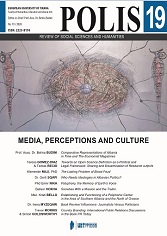Polyphony, the Memory of Earth’s Voice
Polyphony, the Memory of Earth’s Voice
Author(s): Ermir NikaSubject(s): Cultural history, Museology & Heritage Studies, Music, Cultural Anthropology / Ethnology, Sociology of Culture
Published by: Shtëpia botuese “UET Press”
Keywords: Cultural Heritage; Polyphony; Art; Interpretation; Culture; Time; Traditions; Study; Value;
Summary/Abstract: Albanian and international cultural heritage couldn’t be understood without Polyphony and vice versa, Polyphony would be an endangered value if it was not included and valued as one of the main limbs of cultural heritage. Studies have shown that in it, Polyphony is not and constitutes only a value of the past but at the same time and manner it represents even the most representative features of contemporaries. It still preserves the identity characteristics which have defined it as one of the most original genres of folklore, which testifies to its non-alienation over the centuries against the assimilative spirits that have described the History of Albania. Many local and foreign critics have shed light on and analyzed the artistic evidence of polyphony in different regions, the forms of interpretation and the features of the lyrics in its entirety as well as the history and graphical context. In addition to different opinions, unanimity but also polemics and in different ways of view on this cultural and artistic phenomenon, all scholars have shed light and treated Polyphony from different perspectives by continuously completing the research angle and at the same time emphasizing on its role and importance in preserving and further strengthening the identity of the Albanian society, despite the conditions and influences from other cultures that have described the Albanian socio-cultural climate. Despite the different points of view in period of time spanning, Polyphony is considered as a space where verse joins the sound in completed harmony between them, preserving intact the form and peculiarities of artistic interpretation, as a sign the directness of the country and the role it has played in tradition, as well as in the contemporary and at the same time the future that does not tend to tear or touch this foundation of our society.
Journal: Polis
- Issue Year: 1/2020
- Issue No: 19
- Page Range: 68-86
- Page Count: 19
- Language: English

